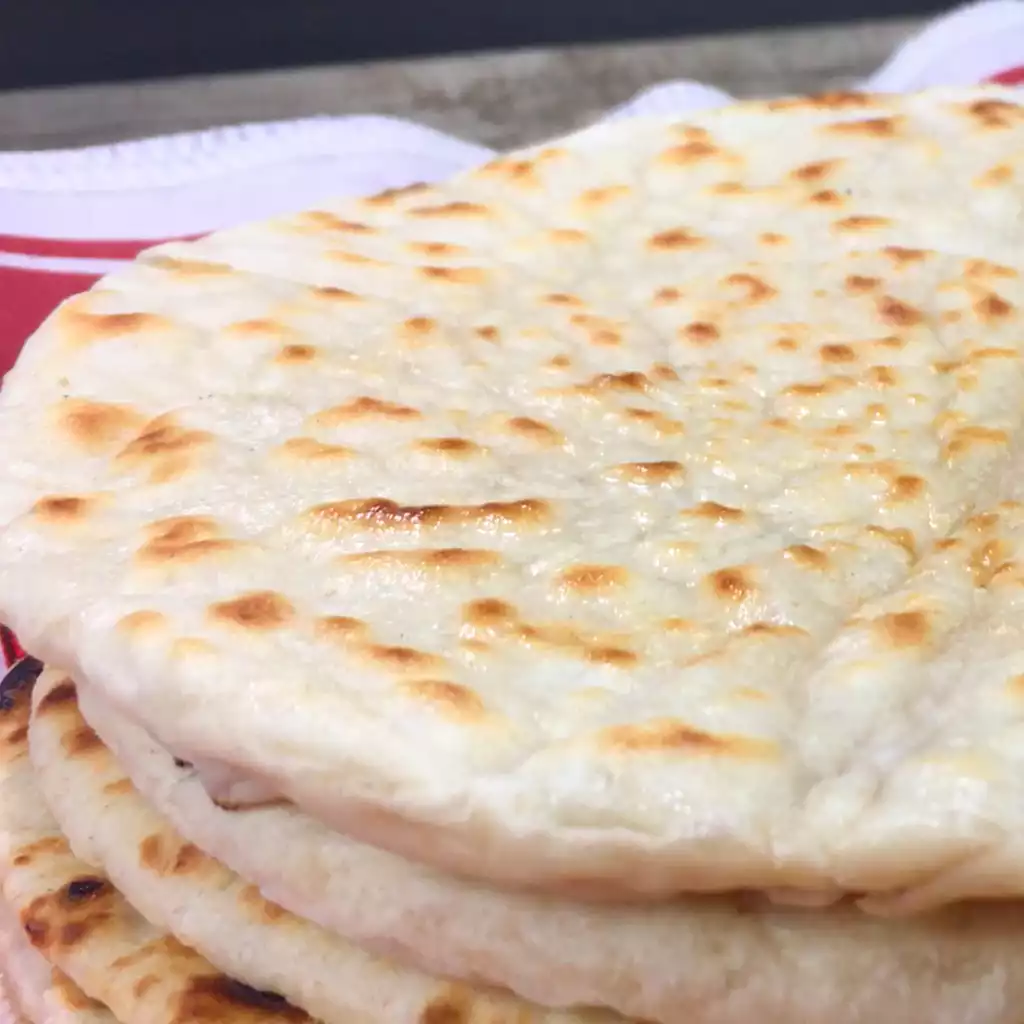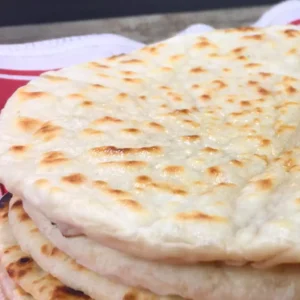
Turkish bread, also known as “bazlama,” is a traditional delight hailing from the rich culinary heritage of Turkey.
With its origins deeply rooted in Turkish culture, this bread has become a staple not only in Turkish cuisine but also across the globe. Its simplicity in ingredients and versatility in usage make it a favorite among bread enthusiasts of all skill levels.
Creating Turkish bread is a journey that balances simplicity with flavor. While the ingredients are basic pantry staples, it’s the technique and finesse in kneading and cooking that truly bring out the authentic taste and texture of this bread.
Despite its rustic appearance, mastering the art of making Turkish bread may take a few tries, but the process itself is deeply rewarding.
Expert Tip: Don’t skip the step of brushing the cooked bread with butter or oil before serving. This adds an extra layer of flavor and helps keep the bread moist and tender.
Plain Flour: Plain flour provides the structure and texture needed for this recipe. Its finely ground consistency helps create a soft and elastic dough that is easy to work with.
Salt: Salt not only enhances the flavor of the bread but also helps to regulate the fermentation process. It brings out the natural taste of the other ingredients and balances the overall flavor profile.
Yeast: Yeast is the key to achieving that light and airy texture in Turkish bread. It activates during the fermentation process, causing the dough to rise and develop a fluffy interior while maintaining a golden crust.
Water (Warm): Warm water helps to activate the yeast, allowing it to ferment and leaven the dough effectively. It also hydrates the flour, promoting gluten development and ensuring a tender crumb.
Milk: Adding milk to the dough enriches the flavor and adds a subtle richness to the bread. It contributes to the softness of the crumb and helps achieve a golden brown crust when cooked.
Olive Oil: Olive oil not only adds moisture to the dough but also lends a subtle flavor and aroma to the finished bread. It creates a tender texture and enhances the overall taste experience.
Expert Tip: When rolling out the dough, aim for a thickness of approximately 1cm to achieve the perfect balance of softness and chewiness in the finished bread.
Expert Tip: Ensure that the water used in the recipe is warm but not too hot, as hot water can kill the yeast and prevent the dough from rising properly.
Yes, you can substitute instant yeast for active dry yeast in this recipe. However, you may need to adjust the quantity slightly, as instant yeast is typically more potent. Use about 25% less instant yeast than the amount of active dry yeast called for in the recipe.
The dough should be left to rise for at least 30 minutes, or until it has doubled in size. However, the exact time may vary depending on factors such as room temperature and humidity. Keep an eye on the dough and wait until it has visibly expanded before proceeding with the next steps.
Yes, Turkish bread freezes well. Once it has cooled completely, wrap it tightly in plastic wrap or aluminum foil and place it in an airtight container or freezer bag. To thaw, simply leave it at room temperature for a few hours or overnight in the refrigerator. You can then reheat it in a preheated oven or toaster oven until warmed through.
Yes, you can adjust the size of the portions to suit your preferences. For smaller bread, divide the dough into more portions, and for larger bread, divide it into fewer portions. Just keep in mind that the cooking time may vary depending on the size of the bread, so keep an eye on them while cooking to avoid over or undercooking.
Here are some more recipes for you to enjoy! If you my recipes don’t forget to rate and leave a comment.
If you have any recipe suggestions, please do not hesitate to ask me. A great way to stay in contact with me is through Instagram, Facebook, Twitter and YouTube. Don’t forget to tag me @CookwithNabeela in your recipe photos!

Subscribe now to receive my latest recipes directly in your inbox. Stay up-to-date and never miss out!

I love to cook! I want to share with you my favourite, delicious family-friendly recipes. I want to inspire you to create fantastic food for your family every day.
Latest comments (16)
This now a family favorite. I let thw dough sit covered for at least one hour and they come out wonderful every time. We cannot consume dairy so I substitute the milk with unsweetened almond milk instead. I wish I could add pictures as we have achieved some very impressive air pockets. Thank you for posting this recipe.
That’s awesome to hear! I’m so glad it’s become a family favourite for you. The almond milk swap sounds like a great idea! Thank you so much for sharing your experience, and I bet those pictures would look incredible! 😊
I have made this a few times now. My husband and I love it! Although I do not get the same rise that I see in your video when I flip it over but it still tastes great!
That’s great to hear! I’m glad you and your husband are enjoying the Turkish bread recipe. Thank you for trying it out and sharing your feedback!
Made it last night. It was wonderful. I mixed it and let it rise in my bread machine because I can’t knead. Truly lovely. Better than nan. I will never pay five bucks for nan again!
Thank you so much for trying out my Turkish bread recipe! I’m thrilled to hear that you enjoyed it and found it easy to make in your bread machine. I agree, homemade bread is always so satisfying and delicious, especially when you can tailor it to your liking. And yes, it’s definitely a cost-effective alternative to buying naan bread. Thanks again for sharing your experience and feedback, and I hope you get to enjoy the bread again soon!
Not corrected yet. 500 Gr flour. Delicious and easy recipe.
My apologies! I have amended the recipe 🙂
Would vegan milk work?
Hey,
I’ve not tried it with vegan milk but I don’t think that would be an issue 🙂
I used my homemade soy yogurt and water and it works great in any kind of bread baking. You don’t have to use milk. But if you do, make sure your milk is not the sweetened kind. 😊
I landed on this site after I made bazlama and realized how similar it was to naan. Still trying to figure out the difference between the two as both the ingredients and the method of cooking are the same. 😄 Of course you’d need to brush on the oil/butter after cooking to make it more like naan.
Yes, you could use vegan milk. The taste will be slightly different but it will still taste great 🙂
Hi. The bread looks great. I’m about to try it. Just to let you know, your video says 100g flour not 500g. You might want to correct that!
So is it 100gram or 500 gram
My apologies! It is 500g 🙂
Thanks for pointing that out! It’s 500g, I have amended the recipe 🙂